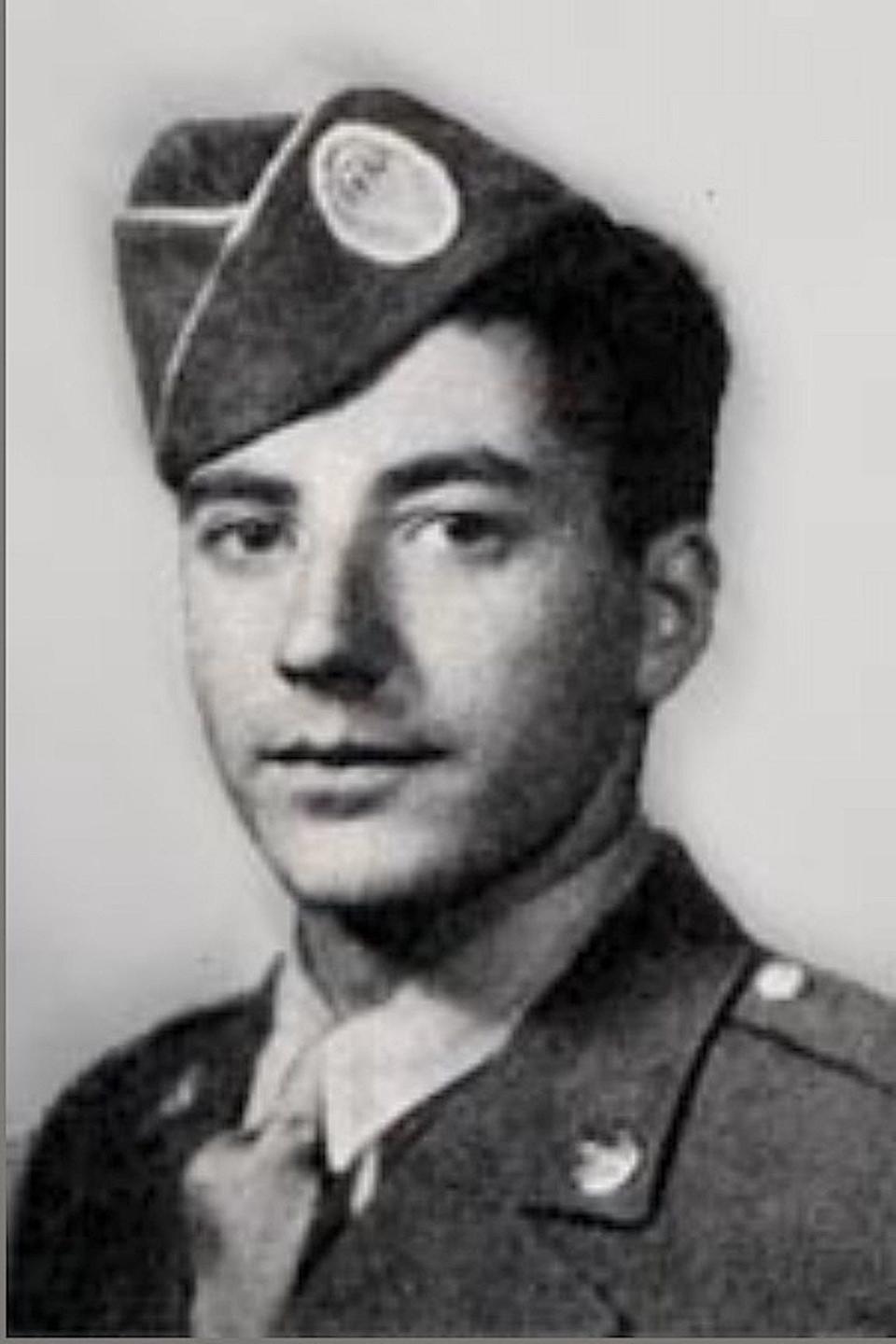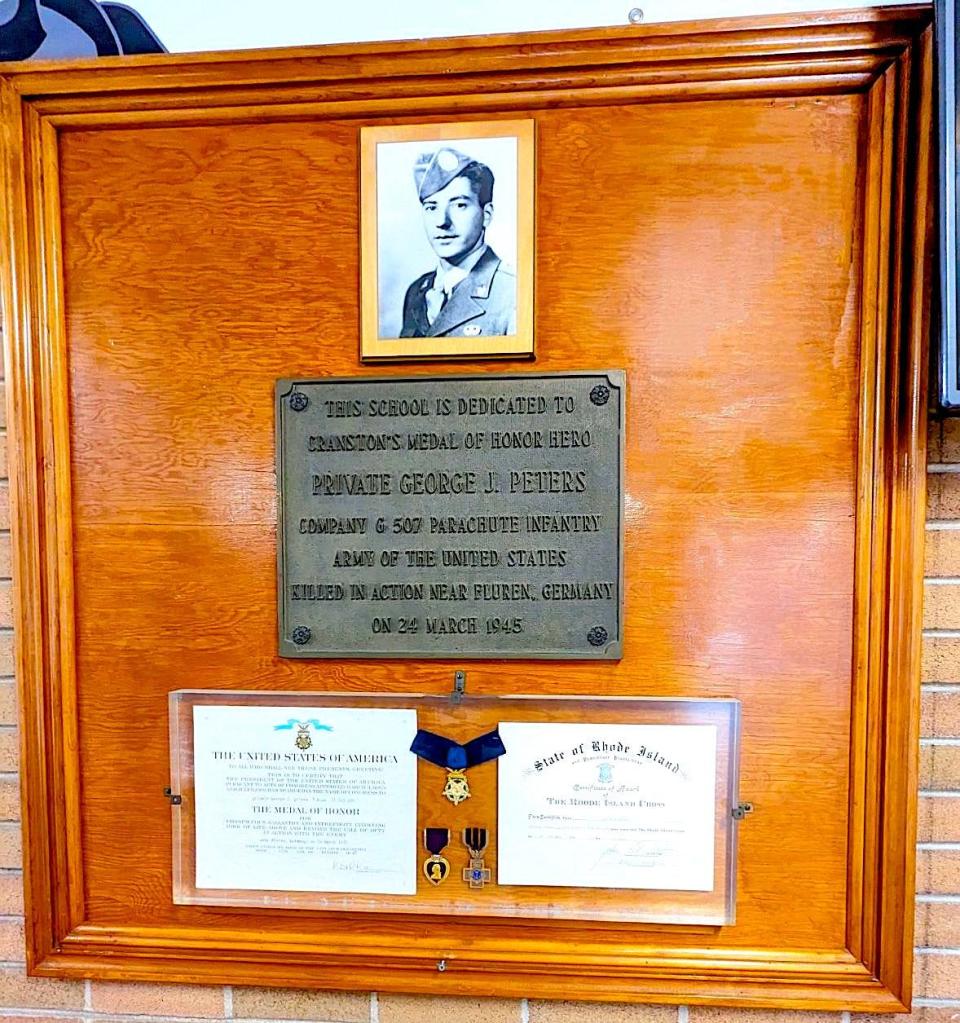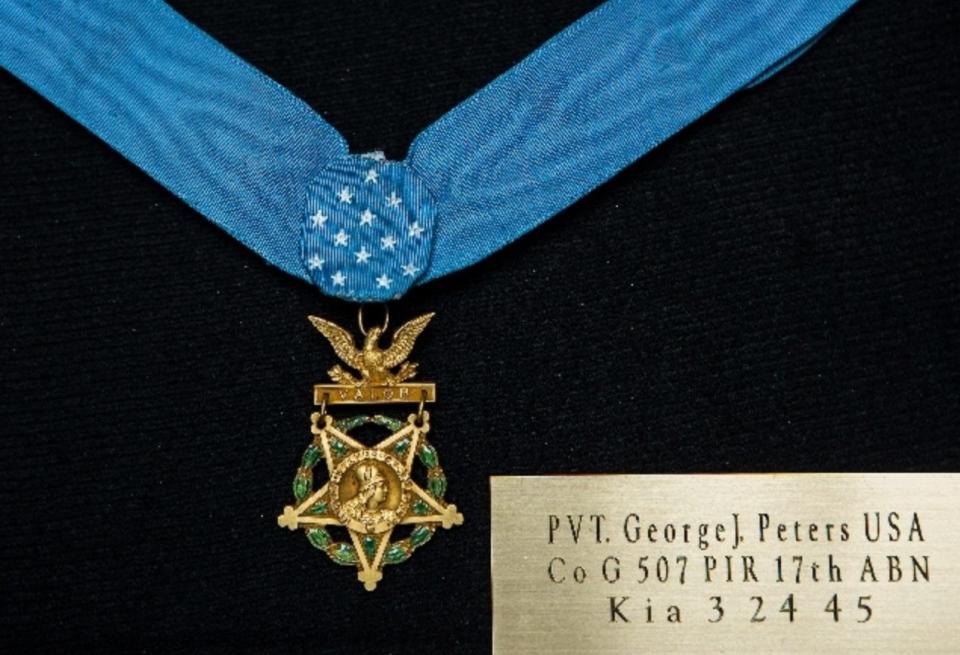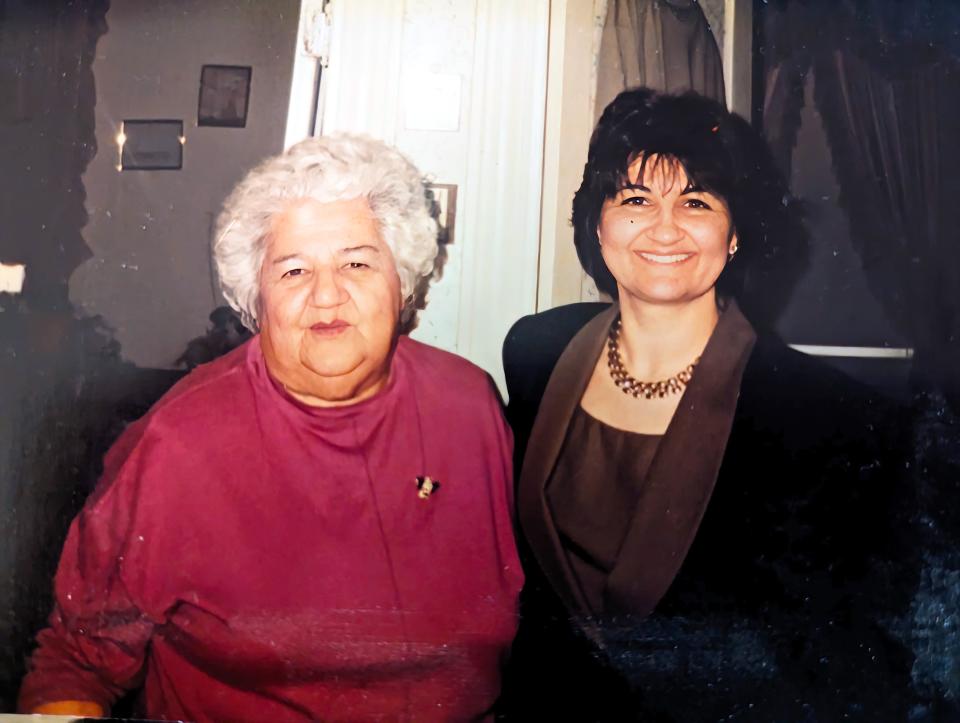Medal mystery: Cranston soldier's WWII heroism earned military's highest honor – twice
- Oops!Something went wrong.Please try again later.
- Oops!Something went wrong.Please try again later.
On March 24, 1945, paratrooper George J. Peters of Cranston and his “stick” of 10 other soldiers from the 507th Parachute Infantry Regiment were among the first to jump into Germany as part of Operation Varsity, the largest airborne operation in history. Thousands of aircraft and gliders carried some 20,000 British and American parachutists to their jump targets behind the German lines.
To give you an idea of the size of this armada, the formation stretched more than 200 miles, and if you were standing in one spot, it would take 37 minutes to pass you.
Soldiers who have fought in big battles always remember them as a large series of small battles, and for Peters this was no exception. By the time Peters and his fellow soldiers hit the ground, they were already under heavy fire from a German machine gun nest and supporting infantry some 75 yards away.

Their heavier weapons and ammunition were dropped separately, and they could not get to them. Seeing his comrades were pinned down and in danger of being wiped out, Peters single-handedly charged the machine gun nest. Knocked down twice by enemy bullets, he crawled close enough to toss grenades into the enemy position, silencing the gun. His fellow soldiers rallied and forced the remaining Germans to retreat. The badly wounded Peters was rescued by his buddies, but he died a few minutes later. It was five days after his 21st birthday.
He is buried in the Netherlands American Cemetery at Margraten, about a two-hour drive from where he was killed at Fluren, Germany.
A posthumous Medal of Honor, and a local tribute
On Feb. 26, 1946, his parents, Mr. and Mrs. Joseph Peters, stood in the office of then-Gov. John O. Pastore for the posthumous presentation of our nation’s highest military recognition – the Medal of Honor. (George Peters was one of only two Rhode Islanders to earn this award during World War II. Last April 10 we wrote about the other, Sgt. William G. Fournier of South Kingstown, who was killed at Guadalcanal in January 1943.)
With “his eyes filling with tears,” according to The Providence Journal, Joseph Peters listened to speakers praise his son’s heroic deeds. A grainy news photo shows Gen. Oscar Griswold presenting the medal on behalf of President Franklin Roosevelt. Mrs. Peters fainted as the ceremonies were completed.

The medal apparently became too heavy for Mr. Peters emotionally, according to George Peters’ niece, Joan Parenteau, who still lives in Cranston. Mr. Peters also felt the medal belonged to the community and sought a place to make it available to the public. When the City of Cranston proposed to dedicate the new West View Elementary School to their son in 1957, the Peters family agreed to donate the medal for permanent display in the school lobby. That display was dedicated on Veterans Day in 1958.
For whatever reason, however, the city procrastinated on its commitment to actually rename the school for Peters.
“My parents always said it was local politics,” said Joan. Perhaps the unpopular Vietnam War had something to do with it, although we will never know.
Despite pressure from local veterans groups, the Peters family and even a nudge from Pastore (who by then was a powerful senator), it took 21 years for Cranston to actually change the name of the school. That finally occurred on Veterans Day in 1979.
A curious discovery at a flea market
Sometime in the early 1970s, retired Army Sgt. Maj. Leo Robillard was wandering through a Cumberland flea market. Robillard had served some 30 years in the military and was a combat veteran of both World War II and Korea. He was stunned to see laid out on one of the cheap display tables a blue presentation box containing a Medal of Honor.
Robillard knew these medals are strictly controlled, but he was more worried about it falling into the hands of a potential imposter or “wannabe.” He pulled out his wallet and bought it.
His son Wayne told a reporter 10 years ago, “I remember him coming home and telling my mom, ‘Look what I found at a swap meet. A guy was selling it. You don’t sell these things.’”
Years later, son Wayne moved to Henderson, Nevada, near Las Vegas. Eventually, his aging parents came to live with him.
They died several years later. Eventually Wayne began sorting through boxes of their belongings, some of which had never been unpacked after the move from Rhode Island.

He found a blue case with the words “United States of America” printed in gold on the cover.
Reporter Keith Rogers of the Las Vegas Review-Journal picked up the story from there on July 6, 2013.
“As he pulled the case from the storage box, it slipped from his grasp and fell to the closet floor. ‘The backing came off and there was this little piece of paper with the name Pvt. George J. Peters, Wayne Robillard said. My dad never took the box apart, so he didn’t know who it belonged to.’”
They looked it up, and, sure enough, George Peters from Cranston, Rhode Island, was listed as a Medal of Honor recipient.
Where did the second medal come from?
The Peters family confirms this isn’t the original medal, which has been in a display case in a Cranston school since 1958.
How the second medal came to exist remains a mystery to this day.
I spoke with Laura Jowdy, curator of the Congressional Medal of Honor Society in Charleston, South Carolina. She is as surprised and puzzled as everyone else. While it is theoretically possible that a duplicate medal could have been created at some point for the family, she said it is “extremely rare” for one to be made for the family of a posthumous recipient. The society also has no record of a duplicate having been ordered or issued, though she acknowledged that “record keeping 60 or 70 years ago was not as good as it is today.”
Also arguing against the theory of a duplicate is the fact that the back of the medal was not engraved to Peters. And Joan Parenteau firmly believes that no one in her family ordered a duplicate.
“Remember, George’s parents wanted the medal out of their home," she said. "It is inconceivable that they would donate the medal to the school, then order another one.”
The next thought (and concern) was that the second medal might be counterfeit. In the 1990s, the manufacturer who held the government contract to produce Medals of Honor did a “production overrun” – to the tune of 300 fake medals. They then sold them on the collector market.
FBI special agent Thomas A. Cottone Jr. investigated that case and made arrests. In 2013, Cottone was asked to look at this particular medal. He declared it to be genuine.

“I don’t have any doubt this is an authentic World War II-era Medal of Honor, but how this medal came to be is a mystery,” Cottone told reporter Rogers.
I circled back with Laura Jowdy, who said the only explanation she could offer was that, “It could be an unpresented medal that somehow found its way out of the military’s inventory.”
Even if it were a medal slated to be engraved to Peters (which might explain the slip of paper in the back of the case), that does not explain how both medals were in Rhode Island within 15 miles of each other in the 1970s.
Second medal is now on display in Las Vegas
After finding the medal, Wayne Robillard’s first thought was to track down the Peters family and offer it back. They reached Isabell Iociofano, sister of George Peters and mother of Joan Parenteau.
“My mom did not want the medal,” said Joan. “We were comfortable with our original at the school. When she heard the alternative plan was to put it on display at a Legion Post in Las Vegas, she was all for it. She thought it was great that people out West would also get to learn about her brother.”
Las Vegas Legion Post 8 made a shadow box for the Medal of Honor and added duplicates of his other awards to the display.
Consider this final thought: Peters’ memorial and grave in Holland is some 3,450 miles east of Cranston. His second Medal of Honor is 2,700 miles west of Cranston. I dare say there are few Rhode island soldiers with that breadth of geographic recognition.
Jos Bex, a Dutch WWII Battlefield Tour Guide, is also a researcher responsible for a memorial to Private Peters in the town where he was killed. From May 7 to 10, he will be visiting Rhode Island to learn more about George Peters. Joan Parenteau is working with Tara Gianfrancesco, principal of the George J. Peters school and Cranston School Superintendent Jeannine Nota-Masse to ensure that Bex's visit is productive and meaningful.
This article originally appeared on The Providence Journal: Medal of Honor mystery follows RI soldier's WWII bravery

